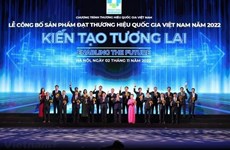Vietnamese silk embroidery finds way to Japan
A group of embroidery artisans in central Thua Thien-Hue province has
long embraced the demanding Japanese market, with more than 2,000
embroidered kimonos exported to Kyoto each year.
A group of embroidery artisans in central Thua Thien-Hue province has
long embraced the demanding Japanese market, with more than 2,000
embroidered kimonos exported to Kyoto each year.
The head of the groups, Le Van Kinh, who has 70 years of experience and is now in his nineties, noted the handicraft work on kimonos requires highly skilled craftsmen and it takes almost a month to complete a single product.
The double sided embroidery technique, in which stitching takes place on both sides of a single transparent silk fabric so that the designs are shown perfectly in the front and reverse, is employed here with an elegant colour blend from white to grey and vice versa, he said.
He went on to reveal that once finished, a traditional piece of the Japanese clothing is valued at over 50,000 USD.
According to Ida Atsushi, Director of Japan’s Sheui company, his business used 20 kimonos and eight belts embroidered by Kinh’s group, which were as fine as the Japanese creations, to showcase at the recent 2015 Hue Traditional Crafts Festival.
Besides kimonos, Le Van Kinh has long been renowned for embroidering poems on silk. Many of his artworks feature text from “Cao Tat Thi Chung” by Zen master Man Giac in up to 14 languages, including English, French, German and Russian. These have been presented at several exhibitions in and out of the country.
Until now, the artisan has passed down the traditional handicraft for more than 100,000 others; and many of them are very well-known across Vietnam.
Le Van Kinh has been honoured with Eminent Artisan title in 2013.
From its heyday during the Nguyen Dynasty, Hue’s embroidery has stood out for its uniqueness and professional character.
When foreigners first set foot on Vietnam, they brought advanced techniques from Western countries, leading to greater variety in Hue’s embroidered products – with some using traditional techniques and others embracing French-style plain embroidery.-VNA
The head of the groups, Le Van Kinh, who has 70 years of experience and is now in his nineties, noted the handicraft work on kimonos requires highly skilled craftsmen and it takes almost a month to complete a single product.
The double sided embroidery technique, in which stitching takes place on both sides of a single transparent silk fabric so that the designs are shown perfectly in the front and reverse, is employed here with an elegant colour blend from white to grey and vice versa, he said.
He went on to reveal that once finished, a traditional piece of the Japanese clothing is valued at over 50,000 USD.
According to Ida Atsushi, Director of Japan’s Sheui company, his business used 20 kimonos and eight belts embroidered by Kinh’s group, which were as fine as the Japanese creations, to showcase at the recent 2015 Hue Traditional Crafts Festival.
Besides kimonos, Le Van Kinh has long been renowned for embroidering poems on silk. Many of his artworks feature text from “Cao Tat Thi Chung” by Zen master Man Giac in up to 14 languages, including English, French, German and Russian. These have been presented at several exhibitions in and out of the country.
Until now, the artisan has passed down the traditional handicraft for more than 100,000 others; and many of them are very well-known across Vietnam.
Le Van Kinh has been honoured with Eminent Artisan title in 2013.
From its heyday during the Nguyen Dynasty, Hue’s embroidery has stood out for its uniqueness and professional character.
When foreigners first set foot on Vietnam, they brought advanced techniques from Western countries, leading to greater variety in Hue’s embroidered products – with some using traditional techniques and others embracing French-style plain embroidery.-VNA













